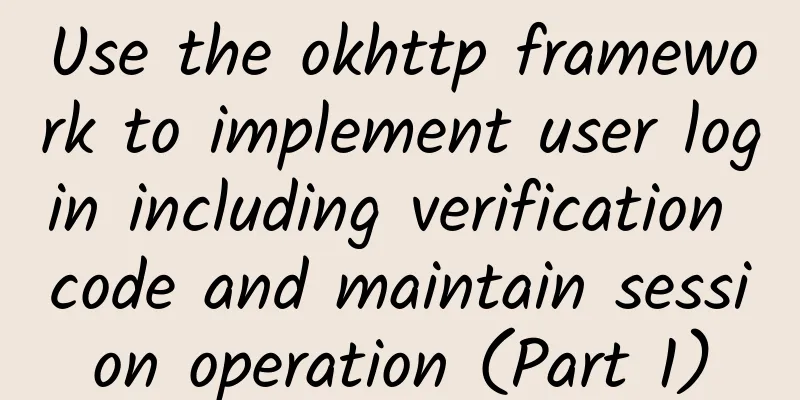Use the okhttp framework to implement user login including verification code and maintain session operation (Part 1)

|
1. What problem does this article solve and what can we learn? I am working on a hospital affairs system project recently, so I will record the process of learning new knowledge. This article is about the login operation. I originally thought that the login process was a relatively simple thing, but after a deeper understanding, it is still difficult: 1. To obtain the verification code photo during the login process, use the HTTP get operation. To pass the parameters to the server, you need to use post. 2. The above get and post operations can be implemented using many current network frameworks, such as volley, but after obtaining the verification code photo, a session must be maintained. Therefore, after consulting the information, it is more convenient and quick to use the okhttp framework to build this project. Let's first learn how to use okhttp: http://blog.csdn.net/itachi85/article/details/51190687 There is also a quick start to load photos using okhttp: http://blog.csdn.net/bo543937071/article/details/53380651 2. Q: What are sessions and cookies? Simply put, cookie is the session ID of the client, and session is the session ID of the server. Based on this ID number, you can query the content of your session. (To learn more about cookies and sessions, click here) http://blog.csdn.net/androidxiaogang/article/details/51925388 In this project, we need to obtain the verification code photo. Because each time you refresh the verification code URL, a different verification code photo will appear, so you need to save the verification code session, otherwise how can others know which verification code you have a "session" with. First, the photo: As shown in the figure, it is divided into four steps, which is easier to understand with text: 1. The client sends a request for a verification code photo, and brings back the photo and a jsessionid field that is stored in the user's cookie. 2. We take out the session from the cookie header, and then pack the parameters and send it along with the session so that the server knows who sent it. The four steps and two points of summary make it easier to understand with the code. 3. Analyze some important codes and then paste all the codes Let's take a look at the data given to us by the backend. There is url_randCodeImage used to send a get request to obtain photos, and url_login used to post data. These are the data we want to package and send: And our xml interface First, we get our verification code photo and load the picture asynchronously
After getting the photos and session, we package and send the data:
***Let's take a look at the information logged out after we successfully logged in *** Here is our full code, I hope it will be helpful to those who don’t understand the process: Continue |
<<: Building iOS Routers Step by Step
>>: iOS Developer Account Summary
Recommend
Virtual operator Xiaomi may not make any big moves within a year
After get off work on November 20, the Ministry o...
The environment inside the tiankeng is dark. Is there life here? Dense primeval forest and independent ecosystem
On the surface, it is difficult to find a corner ...
Why do elevators usually run in the opposite direction of the floor you are going to?
In the preface to Puzzling Mathematics, authors G...
Wang Hongjun: New energy buses face six development trends
From June 5th to 6th, the 2018 (9th) Global Autom...
Introduction to Android hardware acceleration principle and implementation
In the process of developing mobile client, espec...
How can operations break through product bottlenecks?
The product has hit a bottleneck and the order vo...
OPPO Pad 2 all-round tablet review: audio and video, entertainment, light office, all in one
In 2010, the tablet computer was born under the c...
What are the functions of the Lanzhou bottled water mini program? How much does it cost to develop a mini program for delivering bottled water to your door?
Drinking water is an essential part of our daily l...
Android phone RAM can no longer be rolled up, good quality and low price are the best
As the 2022 Android flagships debut one after ano...
Analysis of advertising in the home furnishing industry!
As people's living standards improve, obtaini...
Traditional car companies don't want to fall behind, Ford plans to invest 29 billion in the development of electric vehicles and autonomous driving in five years
The traditional auto industry is continuously inc...
Photos of the reddish lunar soil are black and white? Space cameras are very different from everyday cameras!
On June 25, my country's Chang'e-6 return...
Are you more likely to be struck by lightning if you use your cell phone or wear metal jewelry during a thunderstorm? 6 flood prevention rumors, all explained
We have now entered the flood season, and many pl...
Don't mess with me, I have a heat stroke...
Recently, the temperature in many parts of the co...
Adobe is about to bring these heavyweight tools to the iOS platform
This is a golden age of creativity. We believe th...









